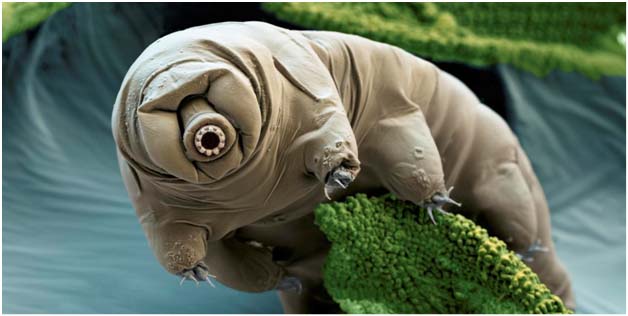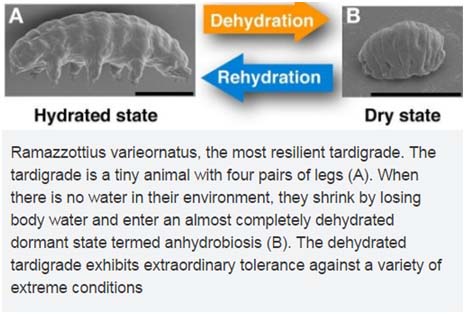A new water bear protein has been found recently which can protect the DNA of human cultured cells from otherwise lethal amounts of radiation damage.
| Q | A |
|---|---|
| Context: | A new water bear protein has been found recently which can protect the DNA of human cultured cells from otherwise lethal amounts of radiation damage. |
| What are water bears? | The water bear, the eight legged- tiny aquatic animal, can survive in many extreme conditions; including temperatures up to 100 degrees Celsius and as cold as absolute zero at minus 273 degrees Celsius, the vacuum of outer space, and extremely high pressures and intense radiation, years of dehydration, massive doses of intense radiation, even can live without food or water for over 30 years. A dry water bear shows no signs of life, but a drop of water can bring it back to normal activity.
There are over 1,000 species of water bears. The creatures grow to about 0.5mm long and get their name from their bear-like claws and podgy frame.
|
| How do water bears manage to do it? | They manage this by going into a state of cryptobiosis, which is when all metabolic processes stop. When they find themselves in better conditions, they come out of the state.
Also they have more copies of an anti-oxidant enzyme and a DNA repair gene than in any other animal. These help counteract oxidation damage when they are dehydrated. In the recent research the DNA of these tiny critters revealed a unique protein capable of protecting cells even human ones from radiation. This protein has been named as Dsup (Damage Suppressor) that protects the DNA when it is irradiated.
|
| What is the significance of it for humans? | For the proper body functions, each cells depends on thousands of proteins to do their jobs in right places at the right times. Sometime gene mutations prevent one or more of these proteins from working properly. When a mutation alters a protein that plays a critical role in the body, it can disrupt normal development or cause a medical condition. A condition caused by mutations in one or more genes is called a genetic disorder.
In some cases, gene mutation is so severe that, they prevent an embryo from surviving until birth. These changes occur in genes that are essential for development, and often disrupt the development of an embryo in its earliest stage. Because these mutations have very serious effects, they are incompatible with life. Human cells are damaged when they’re exposed to X-rays. But in the lab, when the scientists manipulated human cells to be able to create the water bear shielding protein called ‘Dsup’ they showed about half the DNA damage as normal cells. Further, the cultured cells that could create Dsup were still capable of reproducing. It could be helpful for space flight, radiotherapy and radiation workers in the far future. |

